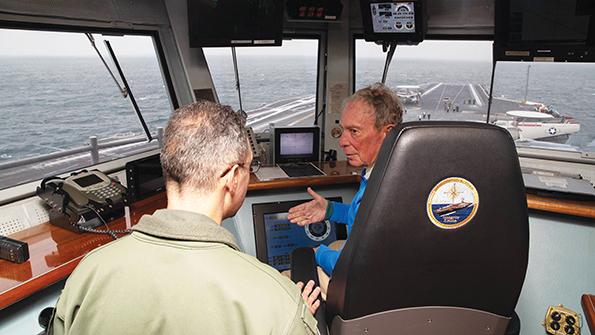Opinion: Supercharging American Innovation for Air And Space Defense

Bloomberg (right) spoke with Lanzilotta aboard the USS Ford.
The American private sector innovates and produces like no other nation in the world. And with Russia’s invasion of Ukraine and the challenges it presents to democracies around the world, there is renewed urgency to find ways to quickly leverage U.S. innovation and ingenuity to defend our values at home and abroad.
At the Pentagon, the challenge of transitioning technology to the battlefield is well known: It’s called the “valley of death.”
When American startups, often from Silicon Valley, are funded to develop cutting-edge technology demonstrations for our nation’s defense, their innovations tend to languish in government bureaucracy, without ever getting integrated into Defense Department operations—and without moving promising technologies from the lab to the battlefield.
This red tape frustrates the Pentagon and Silicon Valley startups alike. But it’s also an issue that Defense Department leaders, particularly Secretary Lloyd Austin, are determined to solve.
Success requires funding more venture-backed companies with robust research and development capabilities while also integrating Defense Department experts into the product development phase. Together, they can more rapidly build, fail, learn, build again and continue learning. Trial and error during development is crucial, and both groups—startups and the Defense Department—must collaborate closely to ensure that the insights they gain are used to build a better mousetrap.
At Bloomberg LP, rapid technological development is a major reason for our success over more than 40 years. From the start, we’ve had a relentless focus on the customer. We continually seek their feedback, which our engineers integrate into product development, so we can build, fail, learn, build again and eventually succeed, in the shortest time possible.
Not all operational strategies in the private sector apply to government, especially when agencies rely heavily on outside contractors. But many critical management strategies do apply, including learning from customers, constantly overseeing progress, holding people accountable for staying on time and on budget, breaking big projects into smaller component parts, using data to identify challenges and target resources, incentivizing risk, being willing to accept failure and recognizing when to double down and when to walk away. Integrating these and other practices more deeply into the Defense Department can help bridge the valley of death.
The department has several efforts underway to incorporate the type of rapid development and implementation that can harness U.S. innovation, and these programs are showing early promise. For example: In July 2022, the department announced the first set of projects to receive funding as part of a program that aims to accelerate the procurement and fielding of innovative technologies. One of the recipients, Shield AI, is a venture-backed company working on the next generation of autonomous uncrewed aerial systems that can provide higher-quality weapon-targeting information through artificial intelligence (AI). These systems can operate in high-wind and extreme weather conditions, which are becoming more common due to climate change and can lower the risk of casualties to service members and civilians.
Weather conditions can be a matter of life or death for pilots. As a licensed airplane and helicopter pilot for three decades, I’ve seen firsthand how new technologies, including AI, have made flying more safe and reliable. And these technologies have largely been the result of private-sector innovation.
Another new Defense Department program decreases the time between development and deployment of commercial drone systems in the field. It reforms the acquisition process by rapidly vetting and approving uncrewed drone systems so they can be quickly deployed, and it ensures that our forces have the latest uncrewed drone technology at their fingertips.
The program, called Blue sUAS, is designed to help U.S. and allied companies rapidly iterate by working “shoulder-to-shoulder” with soldiers to develop and manufacture small and easy-to-use drones. These drones can provide everything from on-demand intelligence and reconnaissance to routine monitoring of facilities, bases and infrastructure.
This collaboration is a prime example of how the Pentagon can tap into the nation’s most dynamic companies and quickly deliver the latest technology to support our men and women in uniform—and I recently saw it in action. In October, I joined Capt. Paul Lanzilotta, commanding officer of the USS Gerald R. Ford, for the carrier’s first deployment, where I saw how the department is investing in new technologies that have enormous potential for improving the efficiency and effectiveness of their operations.
These efforts are yielding real results for the U.S. military. By putting more ingenuity to work at the Defense Department, we can help our service members defend America and our values and interests—and help bring more of them home safely.
Michael R. Bloomberg is the founder of Bloomberg LP and Bloomberg Philanthropies as well as chair of the Pentagon’s Defense Innovation Board. He served as mayor of New York City from 2002 to 2013. The views in this column are his own.




